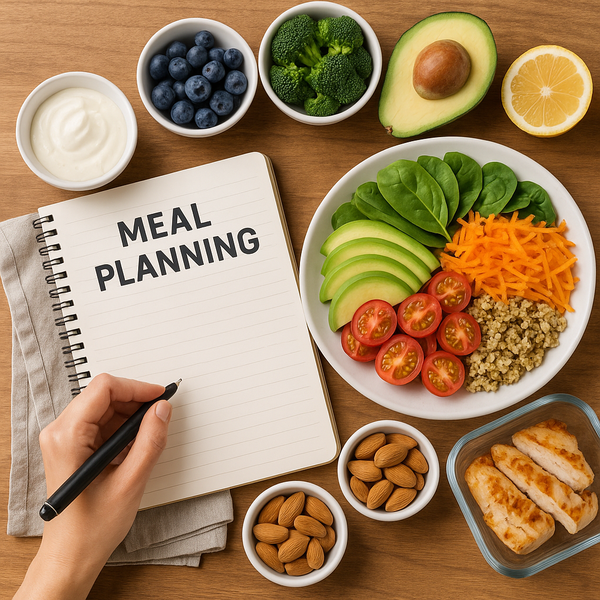
Embarking on the journey of healthy eating can feel overwhelming, but meal planning is a powerful tool to simplify the process. It allows you to take control of your nutrition, save time and money, and reduce food waste. By dedicating a little time each week to plan your meals, you can ensure you have nutritious options readily available, making healthy choices easier and more consistent in your daily life.
Why Meal Planning is Essential for a Healthy Lifestyle
In today's fast-paced world, grabbing quick, often unhealthy, food options can be tempting when time is short. Meal planning directly counters this by ensuring you have prepared or readily available healthy alternatives. It removes the guesswork and stress of deciding what to eat on the spot, often leading to better dietary choices. Planning helps you incorporate a wider variety of nutrients into your diet, as you consciously select different food groups and recipes throughout the week. Furthermore, having a plan helps regulate portion sizes and calorie intake, which is crucial for managing weight and preventing chronic diseases.
Getting Started: The Basics of Meal Planning
Starting your meal planning journey doesn't have to be complicated. Begin by assessing your current eating habits, schedule, and dietary needs or goals. Do you need meals for breakfast, lunch, and dinner, or just one or two? Are you cooking for yourself or a family? Do you have specific dietary restrictions or preferences (e.g., vegetarian, gluten-free, low-carb)? Once you understand your needs, you can start simple. Perhaps plan just a few dinners for the first week, gradually adding more meals as you get comfortable. Choose recipes that are relatively easy and use ingredients you enjoy. Don't aim for perfection; aim for consistency and improvement over time.
Choosing Healthy Foods for Your Plan
The foundation of healthy meal planning is selecting nutritious ingredients. Focus on incorporating a variety of whole foods: lean proteins (chicken, fish, beans, lentils, tofu), complex carbohydrates (whole grains like brown rice, quinoa, oats, sweet potatoes), healthy fats (avocado, nuts, seeds, olive oil), and an abundance of fruits and vegetables of different colors. These foods provide essential vitamins, minerals, fiber, and antioxidants necessary for optimal health. Reading food labels and understanding nutritional information is also a key part of making informed choices. Limit processed foods, sugary drinks, excessive saturated and trans fats, and high-sodium items whenever possible.
Strategies for Efficient Meal Prep
Meal preparation, often referred to as 'meal prep,' is the practical step of cooking or preparing components of your planned meals in advance. This could involve chopping vegetables, cooking grains, batch-cooking proteins, or even preparing entire meals ready to reheat. Dedicated time on a weekend or a free evening can significantly cut down on weekday cooking time. Invest in good quality food storage containers to keep your prepped ingredients fresh. Proper storage is key to food safety and maintaining the quality of your meals throughout the week. Consider prepping versatile ingredients that can be used in multiple meals, such as roasted chicken that can go into salads, sandwiches, or wraps.
Sample Weekly Meal Planning Approaches
There are several approaches to meal planning, and the best one depends on your lifestyle. One common method is batch cooking, where you cook large portions of a few dishes to eat throughout the week. Another is preparing components, like cooking all your chicken or chopping all your veggies on one day. Some people prefer theme nights (e.g., Taco Tuesday, Pasta Friday) to simplify planning. Another approach is freezer meals, where you prepare and freeze meals to be thawed and cooked later, ideal for busy weeks. Experiment with different methods to find what works best for you and your schedule. Flexibility is also important; it's okay to deviate from the plan occasionally.
Incorporating Variety and Flavor
Healthy eating should never be boring! To stick with meal planning long-term, it's crucial to include a variety of flavors and cuisines. Explore different healthy recipes online or in cookbooks. Don't be afraid to use herbs, spices, and healthy sauces to add flavor without extra calories or unhealthy fats. Planning meals from different cultural cuisines can introduce new ingredients and cooking methods, keeping things interesting. Rotate your recipes periodically to avoid meal fatigue. Think about incorporating seasonal produce, which is often more flavorful and nutrient-dense.
Overcoming Common Meal Planning Challenges
It's normal to face hurdles when adopting a new habit like meal planning. Common challenges include lack of time, finding recipes, food spoilage, and getting tired of eating the same things. To overcome these, start small, utilize online resources and meal planning apps, practice proper food storage, and ensure variety in your plan. Don't get discouraged by occasional slip-ups; simply get back on track with your next meal or planning session. Involving family members in the planning and prep process can also make it more enjoyable and sustainable.
Conclusion: Making Meal Planning a Sustainable Habit
Meal planning is more than just writing down what you'll eat; it's a strategic approach to health and well-being. By investing time upfront, you gain control over your diet, save resources, and reduce stress throughout the week. Start small, be patient with yourself, and find methods that fit your unique needs and lifestyle. With practice, healthy meal planning will become a natural and rewarding part of your routine, paving the way for consistent healthy eating and a more balanced life.

